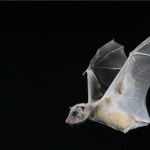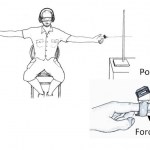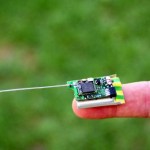Animal navigation
It is a mystery no more: A physical model can explain how a bunch of ants are able, with no visible leader (or highly-developed brains, for that matter) to drag that oversized cake crumb or leaf all the way across your floor to their nest. It turns out that there are, indeed, leaders, of a sort. Those ants you see surrounding the prize being hauled are switching places with other ants that have been scouting out the directions to the nest. The new ants then direct the collective movement, at least for a moment or so until they begin to lose their sense of direction and newer ants take over.…
Not everyone gets their research written about by this week’s Nobel Prize winners:
All mammals face the challenge of navigating in complex, three-dimensional (3D) environments, whether they are swinging from branch-to-branch in forests or burrowing underground tunnels. How does the brain maintain a sense of place and direction in 3D? In a beautiful study published on Nature's website today, Finkelstein et al. report that bats have an internal neural compass that tracks direction in 3D during both surface locomotion and flight.
That’s from Prof. May-Britt Moser in Nature’s “News and Views.”…
We have been told what it’s like to be a bat or a bird; now Prof. Ehud Ahissar and Dr. Avi Saig are getting people to experience what it’s like to be a rat. Specifically, they want the participants in their studies to learn what it’s like to locate things in the dark by twitching their whiskers.
The point, of course, is not to get humans to pretend they are actually rats, but to see how they learn to sense the world with a new sense. Whisking is a fairly complex sense, involving spatial coordinates – horizontal, vertical and distance from the base of the whisker – and timing. It only works…
This week's new Weizmann science stories are on ants and bats. Two different models for investigating human behavior? Yes, but not exactly in the ways you might imagine, and so much more than that.
Dr. Ofer Feinerman, the "ant scientist," is a new member of the Physics Faculty. In his graduate research under Prof. Elisha Moses in the Physics of Complex Systems Department, Feinerman created artificial circuits out of neurons. Now he has turned to investigating the complexities of ant societies. What, you might ask, do neurons and ant colonies have to do with physics? The answer is: They…
Dr. Nachum Ulanovsky of the Weizmann Institute and Prof. Ran Nathan and Asaf Tsoar of the Hebrew University of Jerusalem have captured live fruit bats and glued tiny GPS transmitters to their backs, then driven the bats overnight to a site some 80 kilometers away and rappelled into the bats' caves to retrieve the transmitters after they fall off - all in the name of scientific research. In the process, the team has revealed how these bats form mental maps that they use to return to their favorite fruit trees night after night, often flying large distances and bypassing other, similar trees on…
Millions of years before humans invented sonar, bats and toothed whales had mastered the biological version of the same trick - echolocation. By timing the echoes of their calls, one group effortlessly flies through the darkest of skies and the other swims through the murkiest of waters. It's amazing enough that two such different groups of mammals should have evolved the same trick but that similarity isn't just skin deep.
The echolocation abilities of bats and whales, though different in their details, rely on the same changes to the same gene - Prestin. These changes have produced such…
In the forests of Germany live large numbers of blackcaps, a small species of songbird. They all look very similar, but they actually belong to two genetically distinct groups that are becoming more disparate with time. For the moment, the best way to tell them apart is to wait for winter. As the cold sets in, one group of blackcaps flies southwest to Spain, while a smaller group heads northwest towards Britain.
If the prospect of spending winter in Britain rather than Spain seems odd to you, you're not alone. Indeed, blackcaps were hardly ever ventured across these shores before the 1950s.…
In 2007, Jan Souman dropped three volunteers into the Sahara desert and watched as they walked for several miles, in an attempt to walk in a straight line. Souman was interested in the widespread belief that lost travelers end up walking in circles, a belief that has never been properly tested but has nonetheless become firmly entrenched in the popular consciousness. Just think about Frodo and Sam's hike through Mordor or the three hapless teens in the Blair Witch Project.
To see how non-fictional humans would fare, Souman tracked a group of volunteers using GPS as they walked through a…
For long journeys, the shell of a snail hardly seems like the ideal public transport. That is, of course, unless you're an even smaller snail...
Yasunori Kano from the University of Miyazaki has found that the babies of Neritina asperulata, a tiny snail just 3 millimetres across, hitchhike on the back of a larger species Neritina pulligera. This living bus is about 2 centimetres long, and dwarfs its passengers by more than seven times.
The hitchhiking snail is a special sort of parasite, and one that Kano thinks has never been described before. They don't use their hosts as a snack, a home…
In the movie Finding Nemo, the eponymous clownfish grows up in the security of his home reef and must find his way back after being fry-napped by an overenthusiastic diver. In reality, the larvae of clownfish spend their early lives adrift in the open ocean and only after weeks, or possibly months, do they return to the reefs where they were born.
Their journey is guided by several cues that help them navigate home. The sound of a reef may be one of these but it's clear that the most important sense for a returning fish is smell. Young fish have very well developed smell organs and…
For centuries, farmers have known that their livestock not only gather in large herds but also tend to face the same way when grazing. Experience and folk wisdom offer several possible reasons for this mutual alignment. They stand perpendicularly to the sun's rays in the cool morning to absorb heat through their large flanks, or they stand in the direction of strong winds to avoid being unduly buffeted and chilled.
But cows and sheep don't just line up during chilly spells or high wind. Their motivations for doing so during warm, pleasant and unremarkable weather, or indeed in the dead of…
In a (very) loose tie-in with the recent release of the Dark Knight, it's Bat Weekend at Not Exactly Rocket Science, where I'll be reposting a few old but relevant pieces. If you were a biologist looking for astounding innovations in nature, you could do much worse than to study bats. They are like showcases of nature's ingenuity, possessing a massive variety of incredible adaptations that allow them to exploit the skies of the night.
They are the only mammal group capable of true flight and are one of only four groups of animals to have ever evolved the ability. As a result, they have…
Some of us have enough trouble finding the food we want among the ordered aisles of a supermarket. Now imagine that the supermarket itself is in the middle of a vast, featureless wasteland and is constantly on the move, and you begin to appreciate the challenges faced by animals in the open ocean.
Thriving habitats like coral reefs may present the photogenic face of the sea, but most of the world's oceans are wide expanses of emptiness. In these aquatic deserts, all life faces the same challenge: how to find enough food. Now, a couple of interesting studies have shed new light on the…


